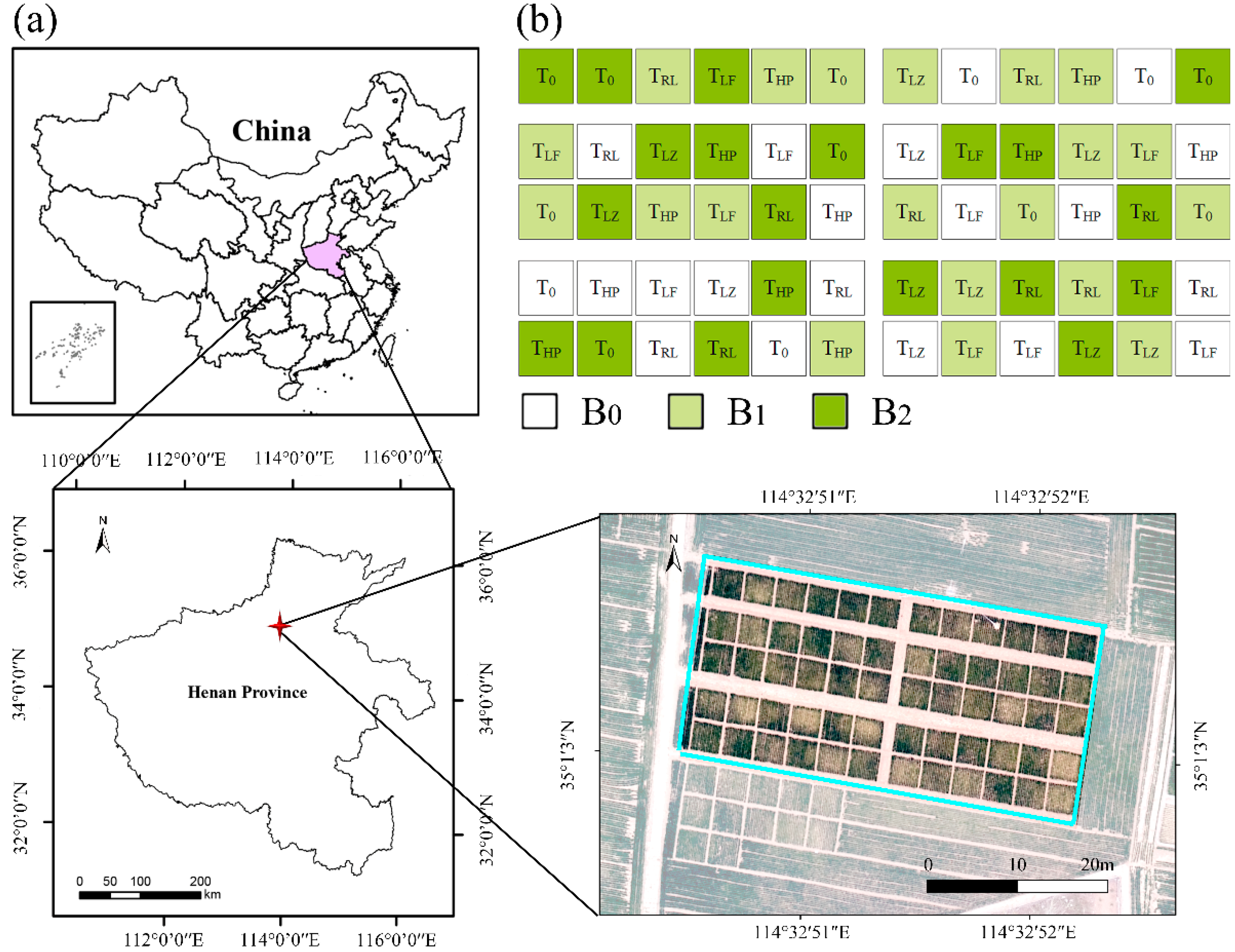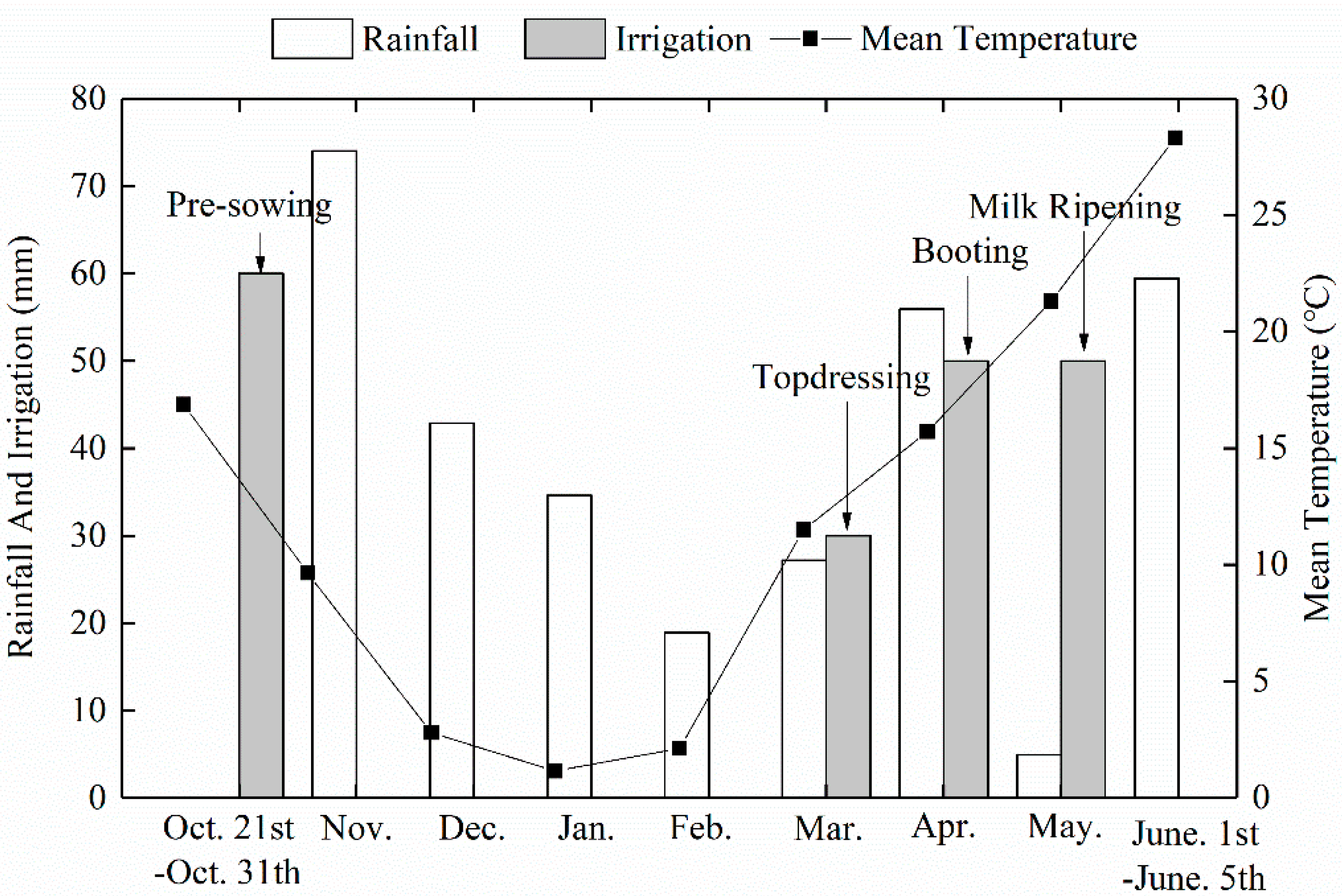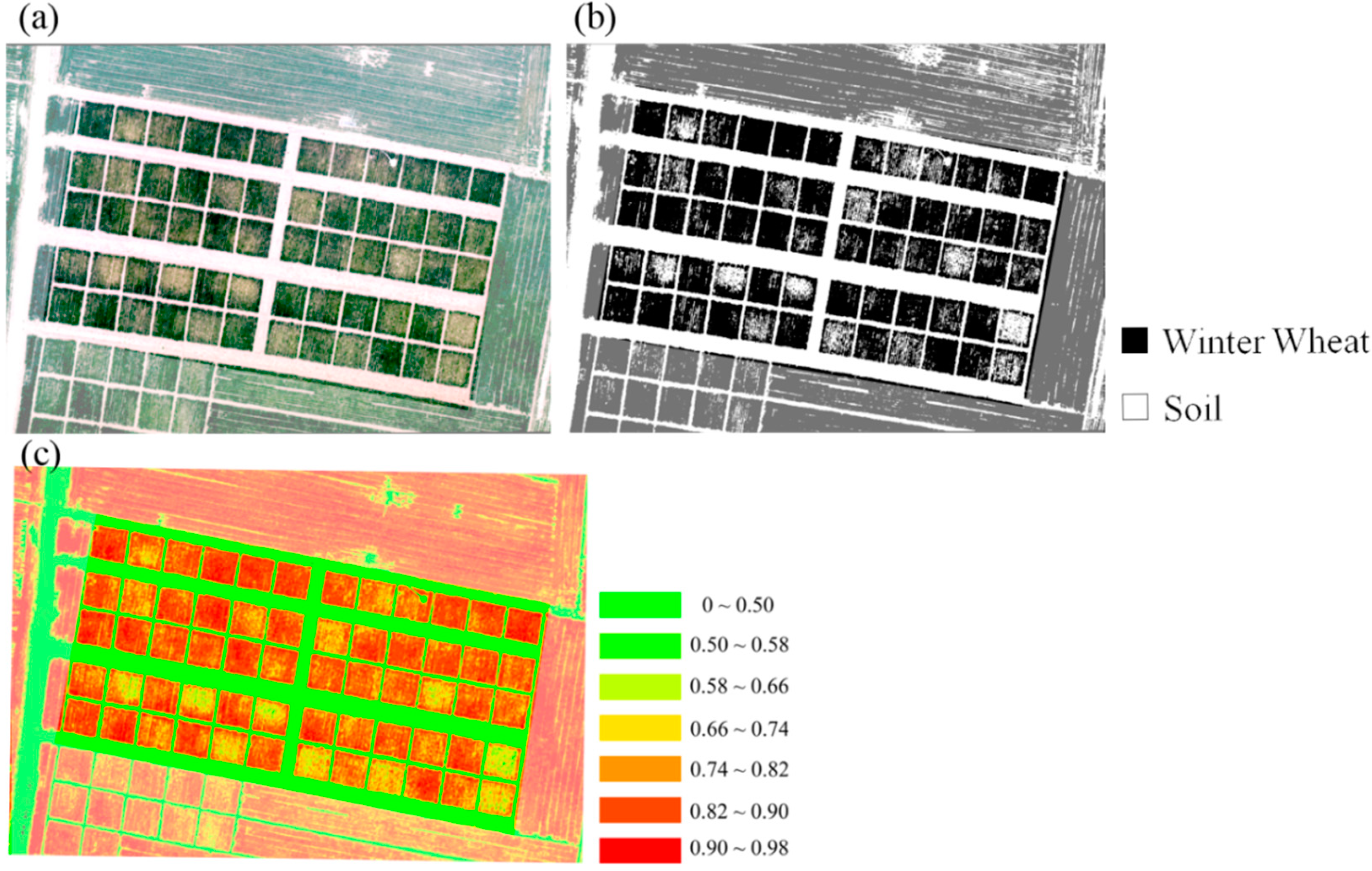Optimization of Topdressing for Winter Wheat by Accurate Growth Monitoring and Improved Production Estimation
Abstract
:1. Introduction
2. Materials and Methods
2.1. Topdressing Methods
2.1.1. THP- Method Based on Improved Growth Estimation
- (1)
- Calculation of the AGB-related parameter RV (cm):where H is the plant height (cm) of winter wheat during the topdressing period and C is the coverage (%) of winter wheat extracted from UAV-based remote sensing images taken at the same time.
- (2)
- Estimation of AGB of winter wheat in the topdressing period (AGBt, Mg∙ha−1) from RV:
- (3)
- Estimation of nitrogen concentration in the aboveground part (NCA) of the topdressing period (Nt, g∙kg−1):
- (4)
- The forage N uptake of the topdressing period (FNUP, kg∙ha−1) was calculated as follows:
- (5)
- Determination of AGB of harvest time (AGBh, Mg∙ha−1):where AGBhm (13.00 Mg⋅ha−1) is the AGB at the harvest time of winter wheat, which received adequate nitrogen during the entire growing period, AGBm (2.15 Mg⋅ha−1) is the AGB during the topdressing period of winter wheat, which received adequate nitrogen before topdressing, AGBth (2.03 Mg⋅ha−1) is a threshold to judge whether winter wheat is under nitrogen deficiency during the topdressing period and AGB∆ (10.50 Mg⋅ha−1) is the maximum increment of AGB from topdressing to harvest:where AGB0 (1.33 Mg⋅ha−1) is the AGB during the topdressing period of winter wheat that received no nitrogen fertilizer.
- (6)
- Estimation of NCA of the harvest period (Nh, g∙kg−1):
- (7)
- Calculation of aboveground N uptake of harvest period (NUPh, kg∙ha−1):
- (8)
- Recommendation of NFT (RN, kg∙N∙ha−1):
2.1.2. TRL- Method Based on Localized NFOA
- (1)
- Calculation of INSEY:where DAT is the days from planting to monitoring, where growing degree days (GDD) > 0; °C, where Tmax and Tmin represent daily ambient high and low temperatures [20]. In this study, the DAT = 88d.
- (2)
- Estimation of PGY (Mg∙ha−1) based on current nutritional status:
- (3)
- Estimation of FNUP from NDVI (FNUPNDVI, kg∙ha−1):
- (4)
- Calculation of the aboveground biomass at harvest (AGBh, Mg∙ha−1):
2.1.3. TLZ- Method Based on Simplified Estimation of Nitrogen Uptake
- (1)
- Estimation of the N uptake from topdressing to harvest period (∆NUP, kg∙ha−1):
- (2)
- Recommendation of NFT (RN, kg∙N∙ha−1):
2.2. Field Experiment
2.3. Plant Sampling and Measurement
2.4. UAV-Based Remote Sensing
2.5. Evaluation of NFT Use Efficiency
3. Results
3.1. Growth Status of Winter Wheat Before Topdressing
3.2. Recommendations of NFT
3.3. Responses of Winter Wheat after Topdressing
3.4. Harvest Index and Nitrogen Use Efficiency
4. Discussion
4.1. Difference in NFT
4.2. Differences in Responses of Winter Wheat to NFT Recommended by Each Topdressing Method
4.3. Limitations of the Study
5. Conclusions
Author Contributions
Funding
Institutional Review Board Statement
Informed Consent Statement
Data Availability Statement
Acknowledgments
Conflicts of Interest
References
- Ren, S.; Guo, B.; Wu, X.; Zhang, L.; Ji, M.; Wang, J. Winter wheat planted area monitoring and yield modeling using MODIS data in the Huang-Huai-Hai Plain, China. Comput. Electron. Agric. 2021, 182, 106049. [Google Scholar] [CrossRef]
- Liu, B.-Y.; Zhao, X.; Li, S.-S.; Zhang, X.-Z.; Virk, A.L.; Qi, J.-Y.; Kan, Z.-R.; Wang, X.; Ma, S.-T.; Zhang, H.-L. Meta-analysis of management-induced changes in nitrogen use efficiency of winter wheat in the North China Plain. J. Clean. Prod. 2020, 251, 119632. [Google Scholar] [CrossRef]
- Xue, L.; Yang, L. Recommendations for nitrogen fertiliser topdressing rates in rice using canopy reflectance spectra. Biosyst. Eng. 2008, 100, 524–534. [Google Scholar] [CrossRef]
- Balasubramanian, V.; Morales, A.; Cruz, R.; Abdulrachman, S. On-farm adaptation of knowledge-intensive nitrogen management technologies for rice systems. Nutr. Cycl. Agroecosyst. 1998, 53, 59–69. [Google Scholar] [CrossRef]
- Liu, S.; Li, L.; Fan, H.; Guo, X.; Wang, S.; Lu, J. Real-time and multi-stage recommendations for nitrogen fertilizer topdressing rates in winter oilseed rape based on canopy hyperspectral data. Ind. Crop. Prod. 2020, 154, 112699. [Google Scholar] [CrossRef]
- Qiang, S.-C.; Zhang, F.-C.; Dyck, M.; Zhang, Y.; Xiang, Y.-Z.; Fan, J.-L. Determination of critical nitrogen dilution curve based on leaf area index for winter wheat in the Guanzhong Plain, Northwest China. J. Integr. Agric. 2019, 18, 2369–2380. [Google Scholar] [CrossRef]
- Torino, M.S.; Ortiz, B.V.; Fulton, J.P.; Balkcom, K.S.; Wood, C.W. Evaluation of Vegetation Indices for Early Assessment of Corn Status and Yield Potential in the Southeastern United States. Agron. J. 2014, 106, 1389–1401. [Google Scholar] [CrossRef]
- Zhao, G.; Miao, Y.; Wang, H.; Su, M.; Fan, M.; Zhang, F.; Jiang, R.; Zhang, Z.; Liu, C.; Liu, P.; et al. A preliminary precision rice management system for increasing both grain yield and nitrogen use efficiency. Field Crop. Res. 2013, 154, 23–30. [Google Scholar] [CrossRef]
- Wood, G.A.; Welsh, J.P.; Godwin, R.J.; Taylor, J.C.; Earl, R.; Knight, S.M. Real-time Measures of Canopy Size as a Basis for Spatially Varying Nitrogen Applications to Winter Wheat sown at Different Seed Rates. Biosyst. Eng. 2003, 84, 513–531. [Google Scholar] [CrossRef] [Green Version]
- Tao, M.; Ma, X.; Huang, X.; Liu, C.; Deng, R.; Liang, K.; Qi, L. Smartphone-based detection of leaf color levels in rice plants. Comput. Electron. Agric. 2020, 173, 105431. [Google Scholar] [CrossRef]
- Raj, R.; Kar, S.; Nandan, R.; Jagarlapudi, A. Precision Agriculture and Unmanned Aerial Vehicles (UAVs). In Unmanned Aerial Vehicle: Applications in Agriculture and Environment; Springer Science and Business Media LLC: Cham, Switzerland, 2019; pp. 7–23. [Google Scholar]
- Tsouros, D.C.; Bibi, S.; Sarigiannidis, P.G. A review on UAV-based applications for precision agriculture. Information 2019, 10, 349. [Google Scholar] [CrossRef] [Green Version]
- Matsumura, K. Unmanned Aerial Vehicle (UAV) for Fertilizer Management in Grassland of Hokkaido, Japan. In Unmanned Aerial Vehicle: Applications in Agriculture and Environment; Springer International Publishing: Cham, Switzerland, 2020; pp. 39–50. [Google Scholar]
- Zhang, M.; Zhou, J.; Sudduth, K.A.; Kitchen, N.R. Estimation of maize yield and effects of variable-rate nitrogen application using UAV-based RGB imagery. Biosyst. Eng. 2020, 189, 24–35. [Google Scholar] [CrossRef]
- Malambo, L.; Popescu, S.; Murray, S.; Putman, E.; Pugh, N.; Horne, D.; Richardson, G.; Sheridan, R.; Rooney, W.; Avant, R.; et al. Multitemporal field-based plant height estimation using 3D point clouds generated from small unmanned aerial systems high-resolution imagery. Int. J. Appl. Earth Obs. Geoinf. 2018, 64, 31–42. [Google Scholar] [CrossRef]
- Bendig, J.; Yu, K.; Aasen, H.; Bolten, A.; Bennertz, S.; Broscheit, J.; Gnyp, M.L.; Bareth, G. Combining UAV-based plant height from crop surface models, visible, and near infrared vegetation indices for biomass monitoring in barley. Int. J. Appl. Earth Obs. Geoinf. 2015, 39, 79–87. [Google Scholar] [CrossRef]
- Furukawa, F.; Maruyama, K.; Saito, Y.K.; Kaneko, M. Corn Height Estimation Using UAV for Yield Prediction and Crop Monitoring. In Unmanned Aerial Vehicle: Applications in Agriculture and Environment; Springer Science and Business Media LLC: Cham, Switzerland, 2019; pp. 51–69. [Google Scholar]
- Xiong, D.; Chen, J.; Yu, T.; Gao, W.; Ling, X.; Li, Y.; Peng, S.; Huang, J. SPAD-based leaf nitrogen estimation is impacted by environmental factors and crop leaf characteristics. Sci. Rep. 2015, 5, 13389. [Google Scholar] [CrossRef] [Green Version]
- Thind, H.S.; Gupta, R.K. Need based nitrogen management using the chlorophyll meter and leaf colour chart in rice and wheat in South Asia: A review. Nutr. Cycl. Agroecosyst. 2010, 88, 361–380. [Google Scholar]
- Raun, W.; Solie, G.J.; Johnson, M.; Stone, R.; Mullen, K.; Freeman, W.; Thomason, E. Lukina, Improving Nitrogen Use Efficiency in Cereal Grain Production with Optical Sensing and Variable Rate Application. Agron. J. 2002, 94, 815–820. [Google Scholar] [CrossRef] [Green Version]
- Raun, W.R.; Solie, J.B.; Johnson, G.V.; Stone, M.L.; Lukina, E.V.; Thomason, W.E.; Schepers, J.S. In-Season Prediction of Potential Grain Yield in Winter Wheat Using Canopy Reflectance. Agron. J. 2001, 93, 131–138. [Google Scholar] [CrossRef] [Green Version]
- Xue, L.; Li, G.; Qin, X.; Yang, L.; Zhang, H. Topdressing nitrogen recommendation for early rice with an active sensor in south China. Precis. Agric. 2013, 15, 95–110. [Google Scholar] [CrossRef]
- Chemists, A.; Horwitz, W. Official Methods of Analysis; Association of Official Agricultural Chemists: Rockville, MD, USA, 1984. [Google Scholar]
- Zhao, B.; Niu, X.; Ata-Ul-Karim, S.T.; Wang, L.; Duan, A.; Liu, Z.; Lemaire, G. Determination of the post-anthesis nitrogen status using ear critical nitrogen dilution curve and its implications for nitrogen management in maize and wheat. Eur. J. Agron. 2020, 113, 125967. [Google Scholar] [CrossRef]
- Tunca, E.; Köksal, E.S.; Çetin, S.; Ekiz, N.M.; Balde, H. Yield and leaf area index estimations for sunflower plants using unmanned aerial vehicle images. Environ. Monit. Assess. 2018, 190, 682. [Google Scholar] [CrossRef]
- Zhou, Q.; Robson, M. Automated rangeland vegetation cover and density estimation using ground digital images and a spectral-contextual classifier. Int. J. Remote Sens. 2001, 22, 3457–3470. [Google Scholar] [CrossRef]
- Richardson, M.D.; Karcher, D.E.; Purcell, L.C. Quantifying Turfgrass Cover Using Digital Image Analysis. Crop. Sci. 2001, 41, 1884–1888. [Google Scholar] [CrossRef]
- Li, B.; Liu, R.; Liu, S.; Liu, Q.; Liu, F.; Zhou, G. Monitoring vegetation coverage variation of winter wheat by low-altitude UAV remote sensing system. Trans. Chin. Soc. Agric. Eng. 2012, 28, 160–165. [Google Scholar]
- Lencina, A.; Weber, C. Maximum discrimination index: A tool for land cover identification. Int. J. Environ. Sci. Technol. 2019, 17, 1113–1122. [Google Scholar] [CrossRef]
- Cassman, K.; Ladha, W.; Reichardt, D. Singh, Opportunities for increased nitrogen-use efficiency from improved resource management in irrigated rice systems. Field Crop. Res. 1998, 56, 7–39. [Google Scholar] [CrossRef]
- Xu, H.-C.; Dai, X.-L.; Chu, J.-P.; Wang, Y.-C.; Yin, L.-J.; Ma, X.; Dong, S.; He, M.-R. Integrated management strategy for improving the grain yield and nitrogen-use efficiency of winter wheat. J. Integr. Agric. 2018, 17, 315–327. [Google Scholar] [CrossRef]
- Cen, H.; Wan, L.; Zhu, J.; Li, Y.; Li, X.; Zhu, Y.; Weng, H.; Wu, W.; Yin, W.; Xu, C.; et al. Dynamic monitoring of biomass of rice under different nitrogen treatments using a lightweight UAV with dual image-frame snapshot cameras. Plant Methods 2019, 15, 32. [Google Scholar] [CrossRef] [PubMed]
- Zheng, H.; Cheng, T.; Zhou, M.; Li, D.; Yao, X.; Tian, Y.; Cao, W.; Zhu, Y. Improved estimation of rice aboveground biomass combining textural and spectral analysis of UAV imagery. Precis. Agric. 2019, 20, 611–629. [Google Scholar] [CrossRef]









| Growth Parameters | Plant Height (cm) | Above Ground Biomass (Mg·ha−1) | Chlorophyll Concentration (μmol·m−2) | Nitrogen Concentration in Above Ground Part (g·kg−1) |
|---|---|---|---|---|
| B0 | 19.33 ± 1.81 (c) | 1.59 ± 0.06 (c) | 540.79 ± 11.39 (c) | 18.05 ± 0.55 (c) |
| B1 | 22.94 ± 2.85 (b) | 1.80 ± 0.05 (b) | 598.94 ± 13.77 (b) | 20.93 ± 0.47 (b) |
| B2 | 25.02 ± 2.04 (a) | 2.10 ± 0.06 (a) | 649.18 ± 15.01 (a) | 22.93 ± 0.66 (a) |
| Remote Sensing Information | NDVI | Coverage |
|---|---|---|
| B0 | 0.77 ± 0.04 (c) | 49.99% ± 9.76% (c) |
| B1 | 0.83 ± 0.02 (b) | 65.98% ± 6.99% (b) |
| B2 | 0.85 ± 0.02 (a) | 76.41% ± 6.62% (a) |
| PFPt | B0 | B1 | B2 |
|---|---|---|---|
| THP | 11.86 ± 1.69(a) | 14.90 ± 2.12 (a) | 9.84 ± 1.65 (a) |
| TLF | 12.01 ± 1.63(a) | 14.72 ± 2.03 (a) | 9.56 ± 1.72 (a) |
| TRL | 10.92 ± 2.56(a) | 12.56 ± 1.74 (a) | 9.37 ± 1.39 (a) |
| TLZ | 11.59 ± 1.85(a) | 14.72 ± 1.80 (a) | 10.12 ± 1.87 (a) |
Publisher’s Note: MDPI stays neutral with regard to jurisdictional claims in published maps and institutional affiliations. |
© 2021 by the authors. Licensee MDPI, Basel, Switzerland. This article is an open access article distributed under the terms and conditions of the Creative Commons Attribution (CC BY) license (https://creativecommons.org/licenses/by/4.0/).
Share and Cite
Ji, J.; Liu, J.; Chen, J.; Niu, Y.; Xuan, K.; Jiang, Y.; Jia, R.; Wang, C.; Li, X. Optimization of Topdressing for Winter Wheat by Accurate Growth Monitoring and Improved Production Estimation. Remote Sens. 2021, 13, 2349. https://doi.org/10.3390/rs13122349
Ji J, Liu J, Chen J, Niu Y, Xuan K, Jiang Y, Jia R, Wang C, Li X. Optimization of Topdressing for Winter Wheat by Accurate Growth Monitoring and Improved Production Estimation. Remote Sensing. 2021; 13(12):2349. https://doi.org/10.3390/rs13122349
Chicago/Turabian StyleJi, Jingchun, Jianli Liu, Jingjing Chen, Yujie Niu, Kefan Xuan, Yifei Jiang, Renhao Jia, Can Wang, and Xiaopeng Li. 2021. "Optimization of Topdressing for Winter Wheat by Accurate Growth Monitoring and Improved Production Estimation" Remote Sensing 13, no. 12: 2349. https://doi.org/10.3390/rs13122349






